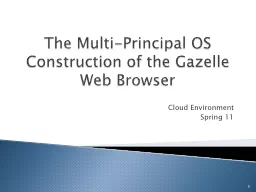PPT-The Multi-Principal OS Construction of the Gazelle Web Browser
Author : catherine | Published Date : 2023-10-04
Presented by Vaibhav Rastogi A new protection scenario Current browsers try to separate host system from Web Websites evolved into web applications Lot of private
Presentation Embed Code
Download Presentation
Download Presentation The PPT/PDF document "The Multi-Principal OS Construction of t..." is the property of its rightful owner. Permission is granted to download and print the materials on this website for personal, non-commercial use only, and to display it on your personal computer provided you do not modify the materials and that you retain all copyright notices contained in the materials. By downloading content from our website, you accept the terms of this agreement.
The Multi-Principal OS Construction of the Gazelle Web Browser: Transcript
Download Rules Of Document
"The Multi-Principal OS Construction of the Gazelle Web Browser"The content belongs to its owner. You may download and print it for personal use, without modification, and keep all copyright notices. By downloading, you agree to these terms.
Related Documents














